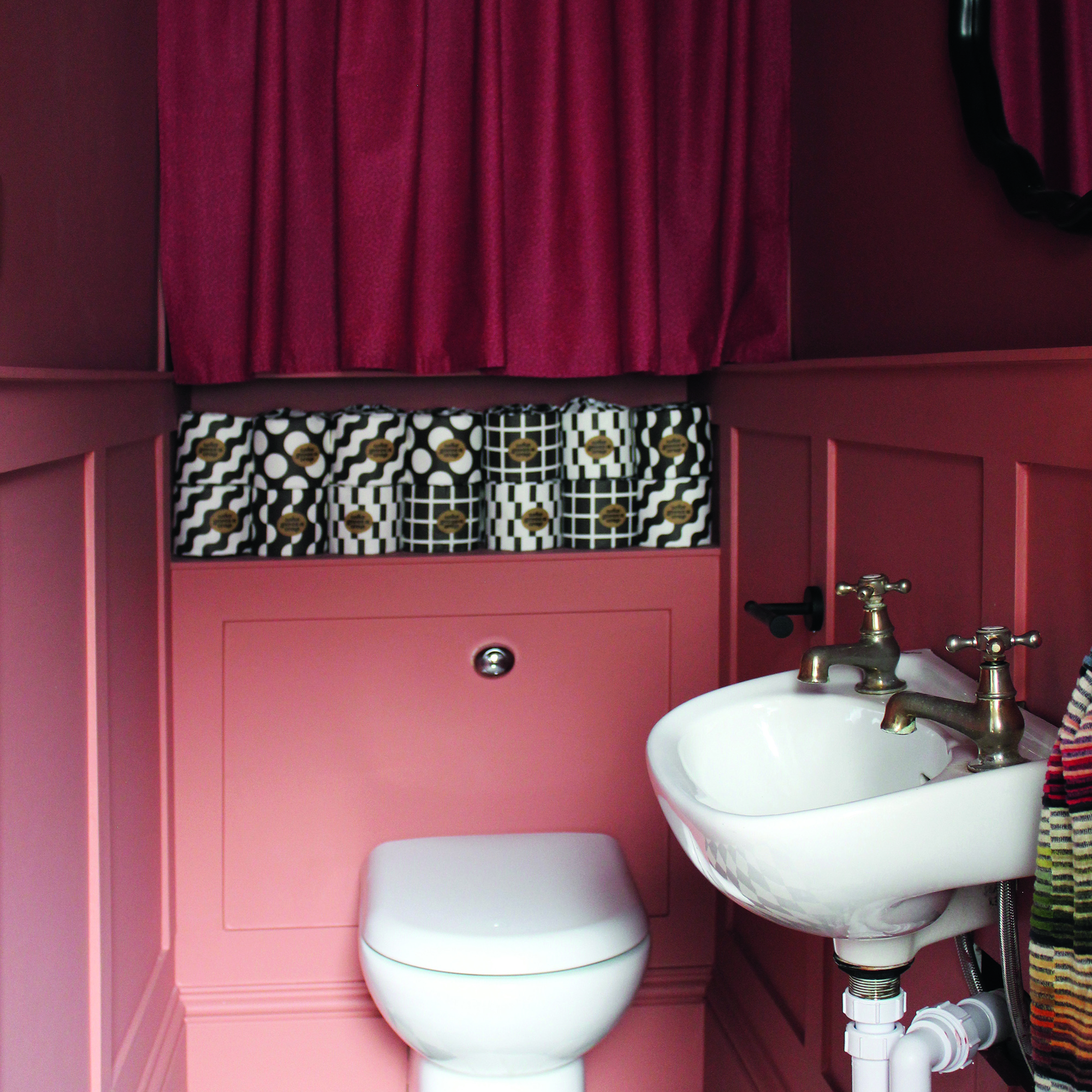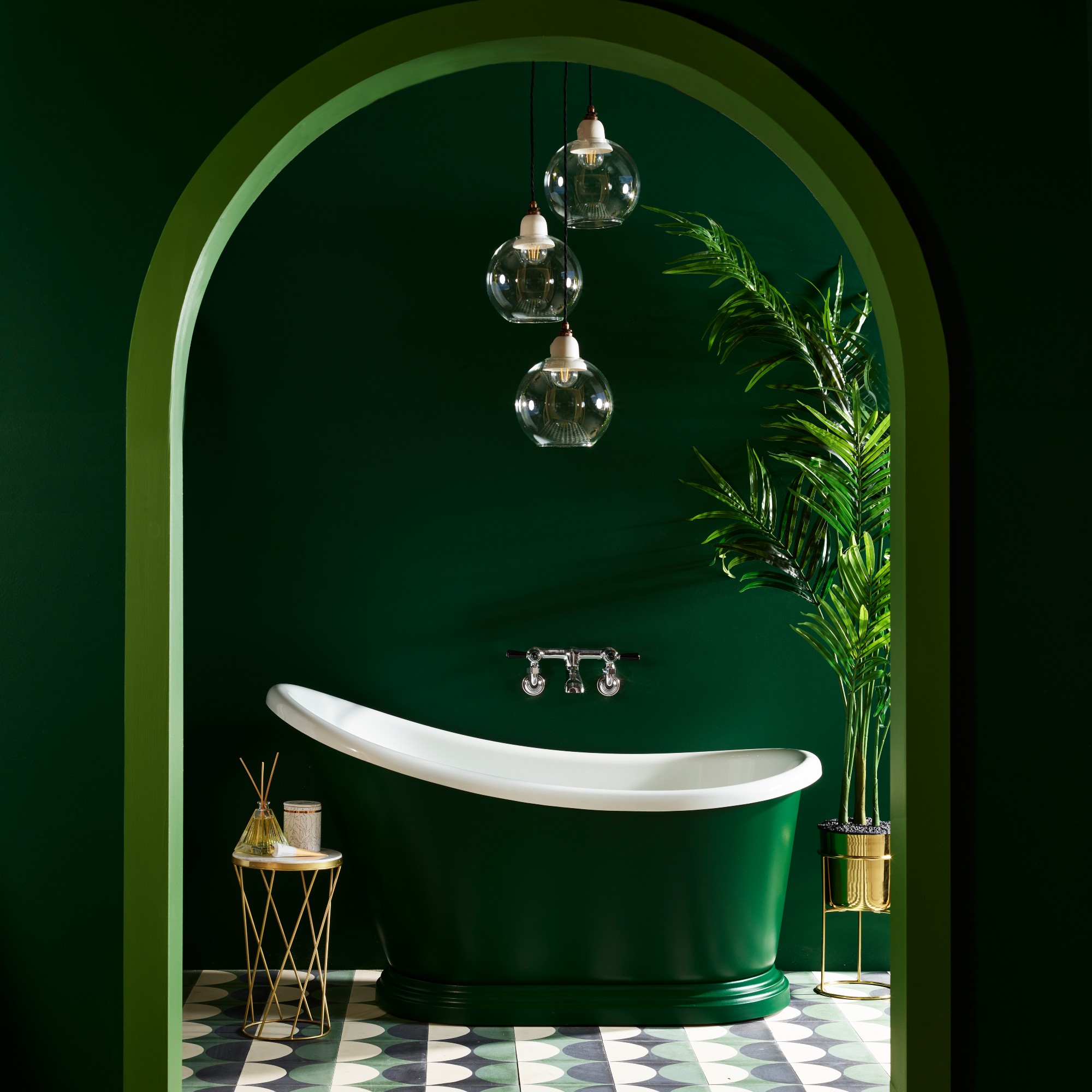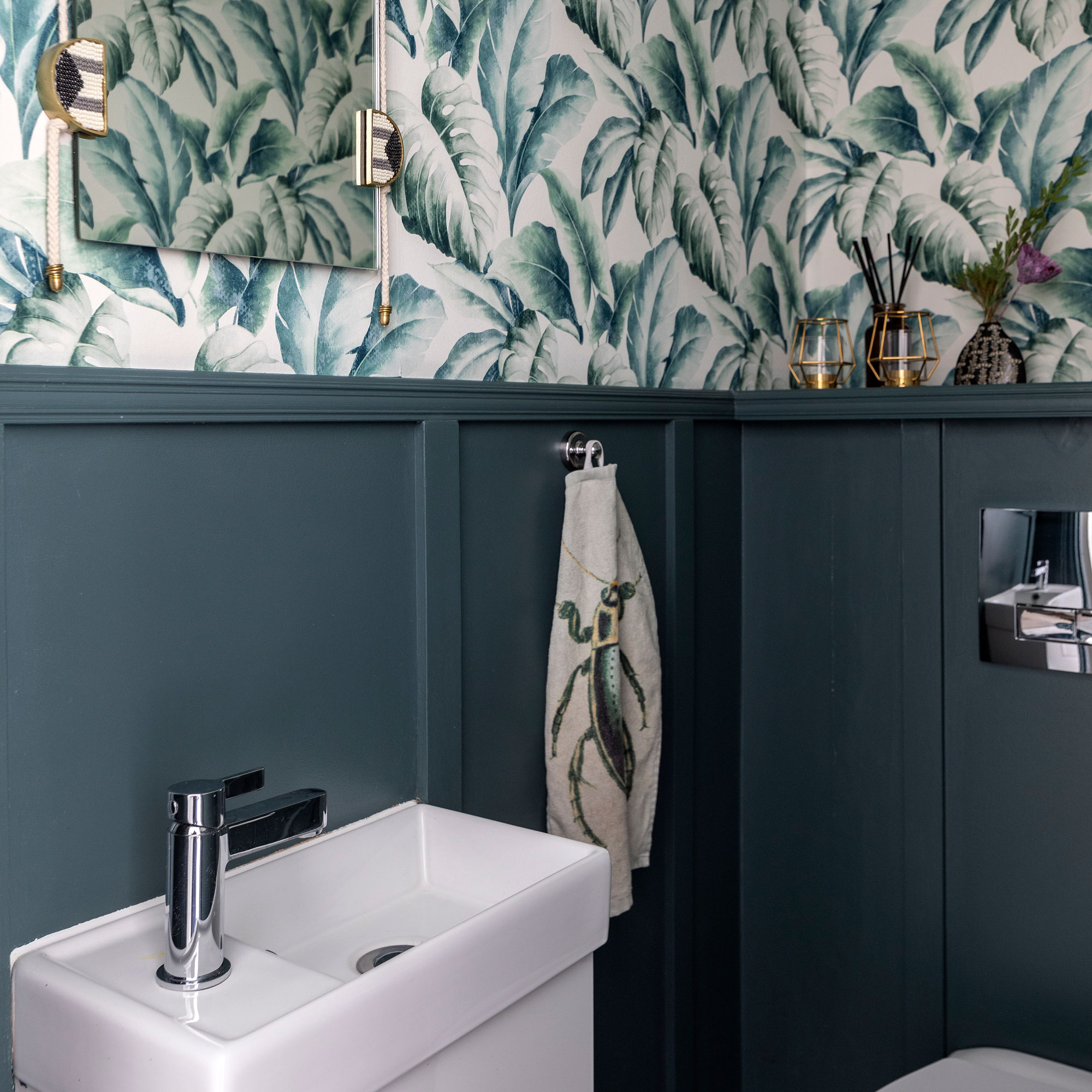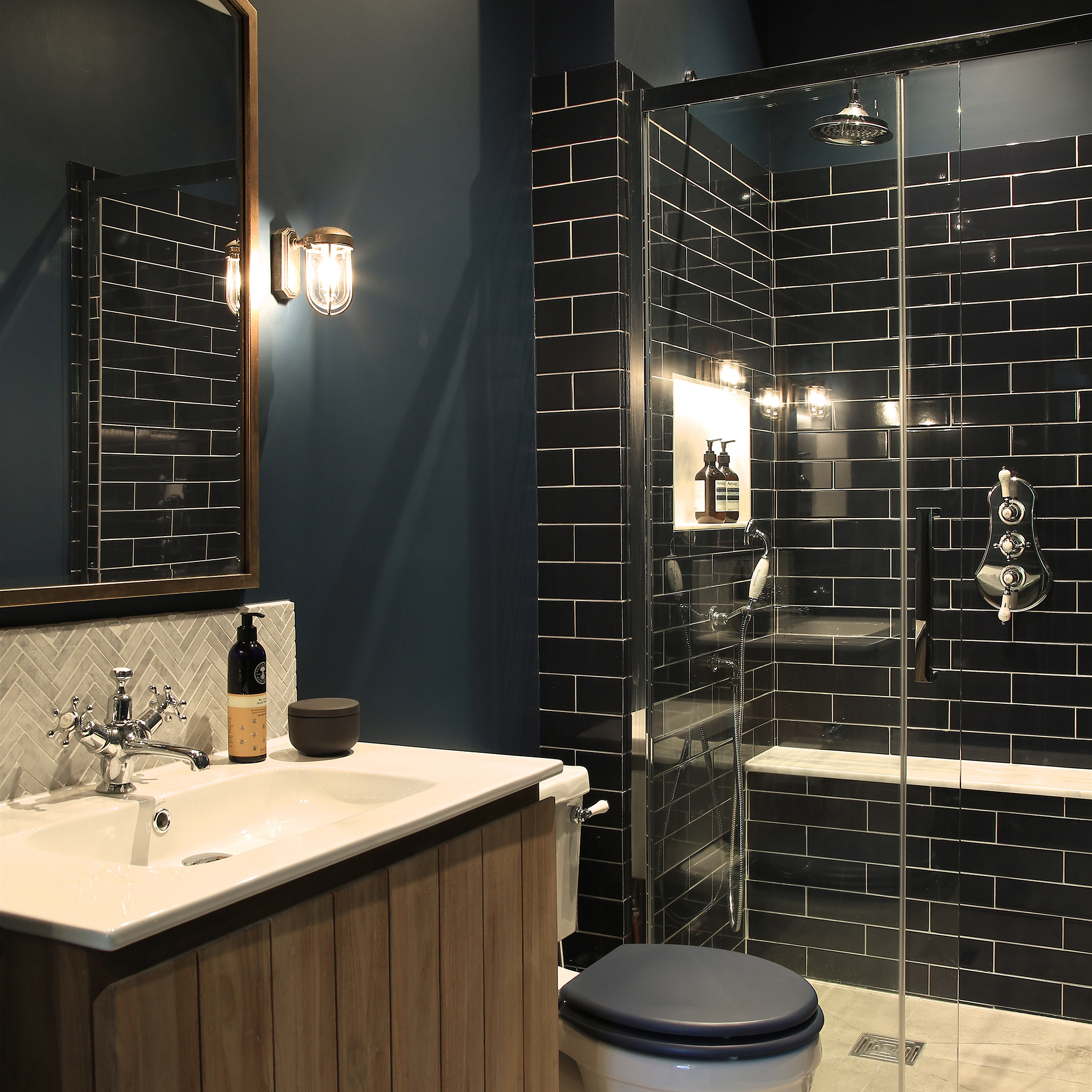
Can a small bathroom be painted a dark colour? The short answer is: of course!
Just because your space is on the petite side, doesn’t mean you can’t go bold with your colour choice. Even the most bijou bathrooms like the downstairs loo can work when painted dark. The secret is to go for it and take care to get the balance right with lighting, mirrors and your choice of fixtures and fittings.
When we chat with our experts about small bathroom ideas, we often talk about getting the lighting right, creating a focal point with tiles or wallpaper and tips on introducing colour – whether it be through blinds, a basin or even statement towels. But what about when you want to add some oomph to your small bathroom colour scheme?
Can a small bathroom be painted a dark colour?
‘Small bathrooms can definitely be painted a dark colour, and in doing so, you can create a really beautiful and sophisticated look. It's a misconception that dark colours can make small spaces feel cramped,’ says Anna Hill, brand director and colour consultant at Fenwick & Tilbrook. ‘They can help to blur the edge of a room, creating the illusion of depth and making the space feel bigger than it is, whilst helping to create an intimate and cosy feel – ideal for transforming a small bathroom into a luxurious retreat.’
Good news! To make a dark shade work in a small bathroom, we asked the experts for some tricks of the trade. Here’s what they had to say.
1. Choose the right shade

‘Darker colours can provide a cosy and enveloping feeling, perfect for achieving the relaxing vibe that most people seek in a bathroom. While it's commonly believed that lighter colours can make a space feel larger, in reality, they may not always have that effect,’ explains Peter Woodward, marketing manager at Scudo Bathrooms.
From deep navy tones and charcoal greys to deep burgundy, rich colours are having a bit of a moment, especially if getting that luxe feel is your aim.
If you want a more natural-inspired look that still has impact, darker earthy tones are increasingly popular too. ‘Ranging from deep moss greens to clays and dusky pinks, shades such as Earthborn’s Hobby Wood and Hobgoblin are easy-going greens with subtle hints of blues for a relaxed and positive space, while the rustic red Lady Bug and Flora’s Tale offer a timeless quality. They’re ideal for bathrooms without windows due to their inherent warm undertones,’ says Bailey Oates, colour expert at Earthborn.
It’s worth thinking about the paint finish too as this can significantly affect the overall look. ‘Matt finishes will absorb light and give a soft, velvety look, whilst glossy finishes will help to reflect light bringing a touch of glamour,’ says Anna. ‘Be sure to test any colour you’re considering out in your space and see how both natural and artificial light in the room will affect how it looks and feels.’
2. Consider natural light

When choosing a dark colour for a small bathroom, it's important to ensure that there is adequate lighting to prevent the room feeling too closed in. This means both artificial and natural light, so where your bathroom windows are situated will have an impact on which colours will work best.
‘If you don’t have windows, choose a dark paint which has warm undertones to help introduce softness to the space as this will help to balance a cooler feeling room,’ says Bailey. ‘To add to the warmth, incorporate lighting in other ways to help the room feel more spacious and complement the tones of paint. Wall lights or lights around a mirror are great examples of ambient lighting without being overpowering.’
Anna agrees: ‘Saturated colours that will add depth without absorbing too much light and incorporate mirrors or glossy tiles to help reflect light back into the room,’ she says.
If your bathroom has plenty of natural light, you can be a bit bolder with your paint choice. ‘You can opt for cooler tones with your paint as the sunlight will help balance them,’ says Bailey.
3. Get artificial lighting right

Bathroom lighting is key in any redesign, but even more so when you’re painting your space in a dark shade. Creating a layered lighting scheme is best. This includes task lighting for areas where you’ll need to do things like wash, shave or put on make-up, ambient lighting to create atmosphere and accent lighting to highlight design features like shower nooks or shelving.
‘Using dimmable spotlights and warm white LED wall lights can offer a softer and more focused alternative to traditional pendant lights,’ explains Peter. ‘In compact bathrooms, vibrant and well-lit vanity units can be exceptionally beneficial. Then, add features like LED mirrors and marble surfaces to further contribute to a well-lit and spacious feel by effectively reflecting and dispersing light throughout the room.’
4. Mix it up

Every small bathroom is individual, so what works in one might not work in another – and that’s ok. In one bathroom, painting the whole space in one daring colour will look striking, but this could be overwhelming in another.
‘I’d advise you to try and incorporate at least two colours into a small bathroom when choosing paint. These can either be opposite colours, so a dark shade and a neutral for example, or two dark colours which share the same tone.’
Creating balance could be as simple as keeping the ceiling and woodwork white or neutral, for example. Then, to give your room depth (and prevent it looking flat), mix tones and textures.
‘For example, if you are interested in painting your walls in a deep navy blue, add other elements in varying blue tones that offer complementary colours and textures. This can be done by painting your woodwork a different colour, installing textured wall tiles to help catch the light or adding blue detailing via wallpaper or accessories,’ Bailey suggests.
5. Experiment with paint effects

While we love a bit of colour drenching for ultimate impact (when you paint the walls, woodwork, ceiling and even radiators in the same shade), being creative with your paint placement can have just as much influence on your bathroom design. How about creating an optical illusion to trick the eye into thinking your small bathroom is actually bigger?
‘A great way to introduce a dark colour and give the optical illusion of space is by painting the bottom half of the wall only with a darker shade,’ says Bailey. ‘This not only adds visual interest but helps disguise any scuffs and marks.’
She also suggests putting your dark paint on their ceiling – the fifth wall – as an element of surprise without the colour being overwhelming. In this case, you could keep your walls lighter with a complementary hue.
6. Create balance with other fittings

Once you’ve decided on your dark paint shade and where you plan to put it, think about the other parts of your small bathroom design, such as the fixtures, fittings, furniture and accessories, as well as the flooring.
‘Lighter colour pieces or metallic accents will help balance the dark walls and help to uplift the space,’ says Anna.
Use mirrors to reflect available light around the room and add more texture through decorative items – remember just because it’s a bathroom, doesn’t mean you can’t bring in things like artwork, plants, trinkets and other things once designated to ‘living’ spaces.
‘Surprisingly, black is a highly versatile shade that can be enhanced with textiles, artificial plants, and gold fixtures,’ says Peter. ‘Paint colours like aubergine also create a similar moody atmosphere and can be emphasised with pops of colour through fabrics, and artwork.’
Our favourite statement bathroom colours
FAQs
How to make a dark bathroom look lighter
When your bathroom is already dark, the first thing to think about is lighting. Does the space have a window? If so, is there a way to boost the natural light coming in by changing up the window treatment?
A detailed or coloured window film might be limiting the amount of light coming into the space, so consider swapping it for a simpler design. You could remove a window film in favour of a blind that can be opened and closed as privacy dictates, or if your bathroom is not overlooked, choose to forego window dressings altogether.
For a dark, windowless bathroom, look to improve the artificial lighting. Go for a mix of overhead and wall lamps to act as task illumination and then add ambient lighting for the atmosphere – with a lit mirror or LED strips within shelving or around the room’s perimeter, for example. If your existing overhead lighting isn’t packing the punch needed, how about switching it to a different style?
Fittings with exposed bulbs tend to let off more light. Then there’s the well-tested trick of adding mirrors. A large mirror will bounce available light around the room and enhance the feeling of space.
What colour tiles work best for a small bathroom?
With so many tiles to choose from and the fact colour is entirely a personal preference, the colour tiles that work best for a small bathroom could be any. Crucially, your shade of tile should be a colour that you love to look at.
Think about where your tiles will be placed. If you’re tiling your whole small bathroom in one design, keep to a lighter tone to enhance the feeling of space. If you love the idea of an all-over pattern, avoid small, intricate or ditsy motifs that can make an already-small space feel smaller – geometrics or bolder patterns usually work better. You could zone a bathing area with a stand-out tile to create a focal point too and add a statement shade by tiling a splashback that catches the eye.
Keep your colour palette restrained to avoid small bathroom tile ideas looking cluttered. How about using different tones of one colour to add depth to your tiling? For example, a bold or dark green pattern for a splashback with a more muted green tile in the shower.
Don't be afraid to go bold in a small bathroom - it'll be entirely worth the risk.







